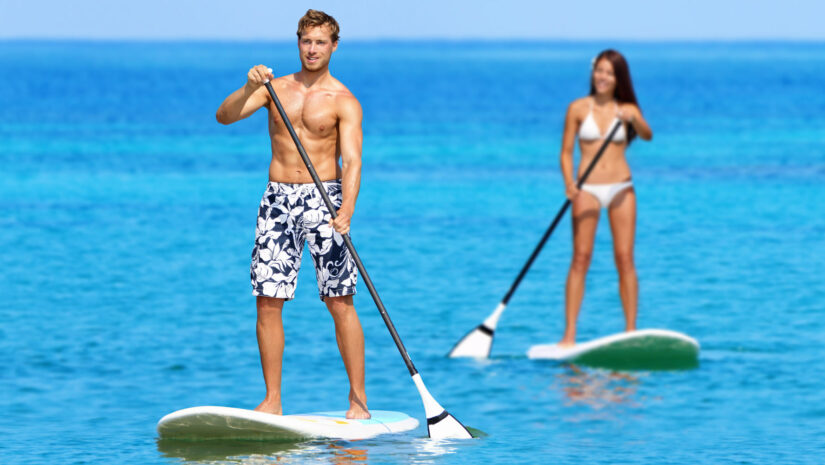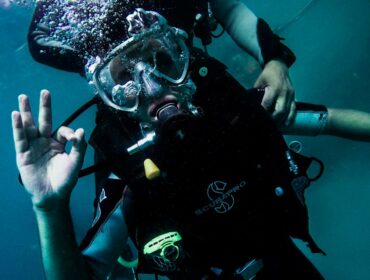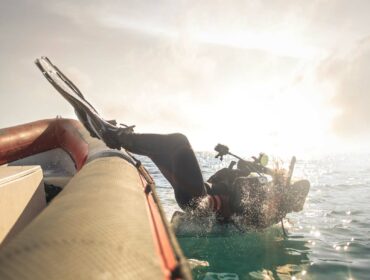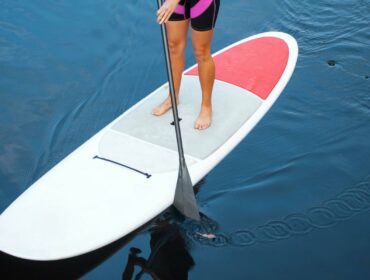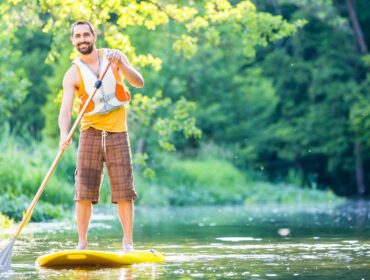Stand up paddle boarding (SUP) is a fun and relaxing activity that allows you to explore the waters without actually swimming or floating in it. The sport, which is basically an offshoot of surfing, involves standing on what appears to be a conventional surfboard and propelling yourself through the water with something that resembles a canoe paddle, only longer. It’s one of the fastest growing water sports in the world and has been adapted to incorporate other enjoyable activities—giving rise to derivatives like SUP Fishing, SUP Yoga, and SUP Racing.
If you’re interested in trying it out, these tips on paddle boarding will help you make the most out of the experience.
Stand Up Paddle Boarding Tips for Beginners
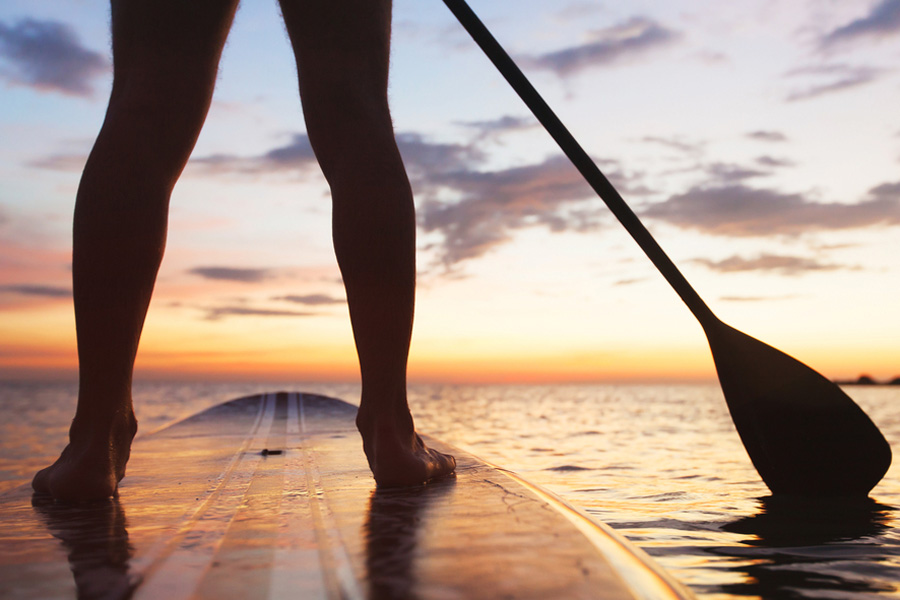
Use a Leash
One of the main things you need to prioritize when engaging in any kind of water sport is safety. And when paddle boarding, you definitely shouldn’t forget to tether yourself to your board with a leash. Your board becomes your life-saving device when you get tired, lost, or when you find yourself a little too far from shore—and you can easily lose it in windy or stormy conditions if you’re not tethered to it.
There are many different types of leashes (straight or coiled) and attachment points (ankle or calf) to suit every paddler’s preference and paddling style. Whatever type of leash you decide on or where you plan to attach it, the important thing to remember is that you need a high-quality board leash that won’t break off but can be quickly detached. This is so that you can easily free yourself in the event that your board gets pulled under by a powerful current or when you become entangled in underwater plants.
While you’re at it, you may also want to get yourself a paddle leash and save yourself the effort of having to swim for it everytime you lose it.
Choose the Right Gear
As with any other sport, having the right gear can be essential to your overall enjoyment and safety. Before you get started in stand up paddle boarding, make sure to get the right SUP gear for your skill level and for the environment you’ll be paddling in.
Typically, it’s best to start with a thick and wide all-around SUP that’s easy to balance on in both flat and wavy waters. You can also opt for a touring SUP, which is both beginner-friendly and ideal for advanced paddlers who want to cruise further and faster.
And of course, make sure to choose the right thickness or volume that suits your body type.
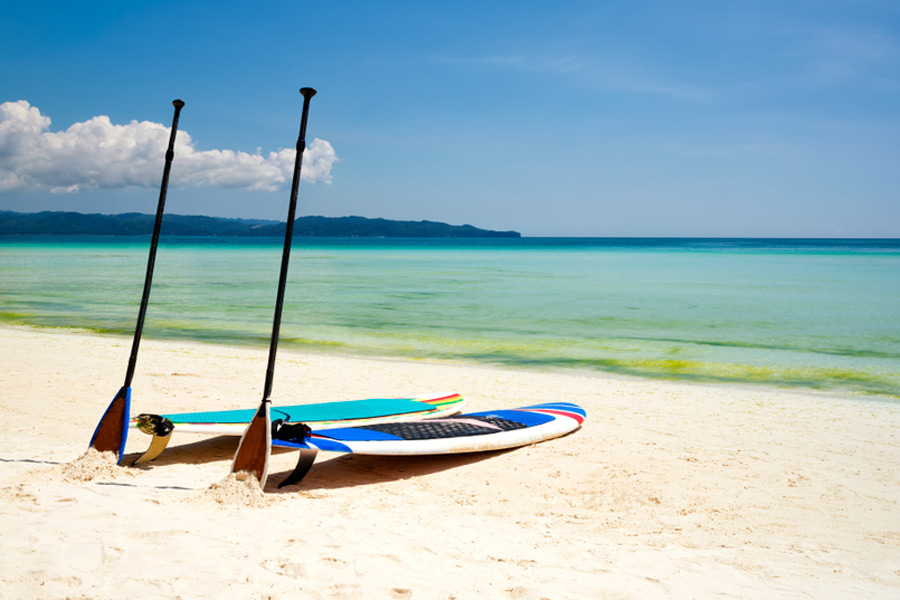
As for your paddle, make sure to get the right paddle length. This will keep you from stooping or bending over, which will help you preserve energy and maintain your stability on the board.
The ideal paddle length may vary depending on the activity you want to engage in, but the rule of thumb is to choose a paddle that is 9 to 10 inches taller than your height.
Check Wind Direction
When you’re standing on your SUP, your body tends to act like a sail—which means strong winds will likely steer you and your board every which way. This makes it much harder for you to paddle and propel yourself to where you want to go, especially as a beginner. Thus, one of the most important (but often overlooked) paddle boarding tips we can give you is to mind the wind conditions. Before even hitting the water, find out the water conditions and weather forecast for that day.
Ideally, the goal is to learn the basics and practice your stability without being bothered by waves and strong winds. In the event that the wind speed and direction becomes a bit too much for you to handle, get low and lie on your board (belly face down with your paddle tucked under your body) and paddle with your arms, as you would with a normal surfboard.
Learn the Correct Paddling Technique
One of the most common mistakes paddle boarders make is that they tend to hold the paddle incorrectly. If you’re just starting out and you’ve had no comprehensive training on stand up paddleboarding, your instinct would be to hold it in a way so that the bent part of the blade is facing you, so you can “scoop” yourself forward.
As it turns out, that’s actually not the right way to use your paddle as it can cause unwanted splashing and make you lose your balance. Flip it over so that the bent part is facing away from you.
Also, make sure to mind your hand placement. Having your hands too close together on the paddle can limit the power of your strokes and may even tire you out faster. Here’s how to find out where you should position your hand (the hand that’s not holding the grip on top) on the paddle:
- Stand up straight and grip the non-blade end of the paddle.
- Hold the paddle horizontally over your head with both hands, then rest the shaft on the top of your head.
- Make sure that the shaft is parallel to your shoulders and that the arm that’s holding the grip creates a perfect 90-degree angle.
- Move the other hand (the one that’s not holding the grip) along the shaft until you create a perfect 90-degree angle with that arm as well.
Engage Your Core
Speaking of techniques, another important paddle boarding tip every beginner should remember is that the actual paddling should be done by your core—not your arms. Your arm muscles will provide much less power and will easily tire out compared to your more powerful core muscles. Engaging your core helps ensure greater efficiency in paddling and allows you to maintain your balance on the board.
Another reason why you should always use your core while paddleboarding? It allows you to get in a good, low-impact workout that will increase your core strength and build muscle definition in your midsection.
Learn how to paddle with your core:
Face the Right Direction
Another mistake that you won’t want to make is to surf with the SUP facing the wrong direction. This can be a common mistake for many beginners, as the front end is not usually obvious to non-paddlers—especially when using an all-around board with a large round nose.
So how do you tell which end goes in front?
The easiest way is to look for the fins and make sure they are in the back, not up front. You’ll know that you and your SUP are facing the right direction when you are able to keep your board straight while you paddle, as opposed to having a twitchy board that forces you to have to keep switching paddling sides.
Keep Your Head Up
As a beginner, it can sometimes be difficult to keep your head up and look straight in front of you as it’s more natural to look downwards (probably because you’re worried about falling into the water). But the thing is, standing straight is extremely important when paddle boarding as it enables you to achieve maximum stability. And if you’re looking down at your feet, your head will obviously be facing down as well.
Standing up on the board is already a pretty difficult feat—but the next challenge is actually staying on it. Stability is key, so avoid looking down as this can ruin your balance. Try your best to keep your head up and maintain good body posture by keeping your back straight, legs slightly bent, shoulders pulled back, and by bearing your body weight mainly on the balls of your feet.
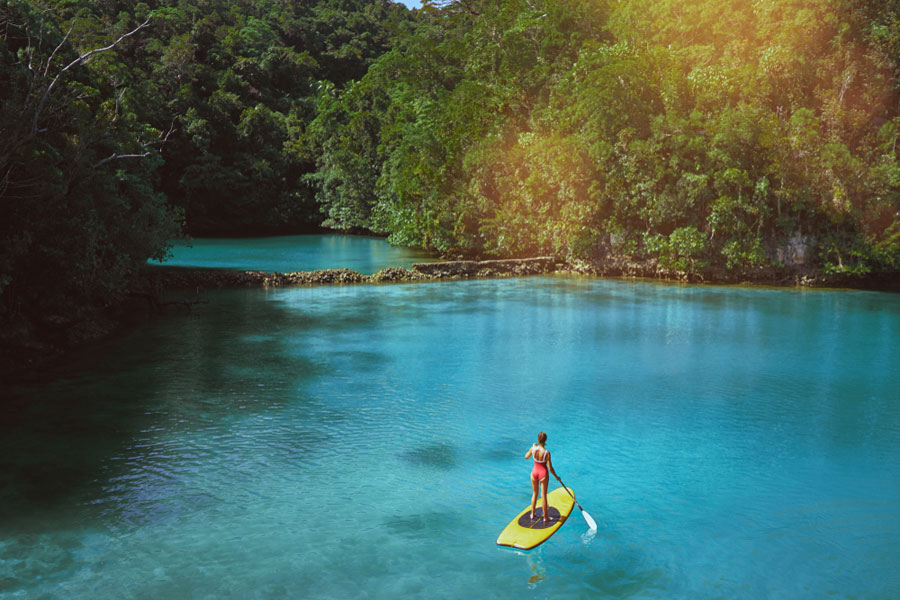
Give Yourself Enough Space
Unless you’re taking group photos, there’s really no reason to be paddle boarding side by side with another paddler—especially if you’re both beginners. Just think: they’ll be creating waves that can cause you to lose your stability, plus they could potentially bump into you. This increases the chances of you falling off your SUP and getting hurt… or hurting someone else.
Therefore, make sure that you have plenty of room to maneuver around—for your and everybody else’s safety. After all, there’s plenty of room in the ocean (or river/lake, depending on where you plan to paddle).
Fall “Away” from the Board
It’s completely natural for any paddler—whether beginner or more advanced—to fall off their SUPs. Falling is inevitable, and aside from making you even more determined to stay on the board, it serves as a good learning experience as it can teach you how you’re supposed to fall so as to minimize injuries.
As standard practice, it’s important to make sure that you fall away from your big and heavy board so that you don’t end up smacking your face on it or getting hit by it. This is particularly important when riding waves and currents.
And don’t worry about the board—as long as you have a leash, you shouldn’t have to worry about losing it in the water.
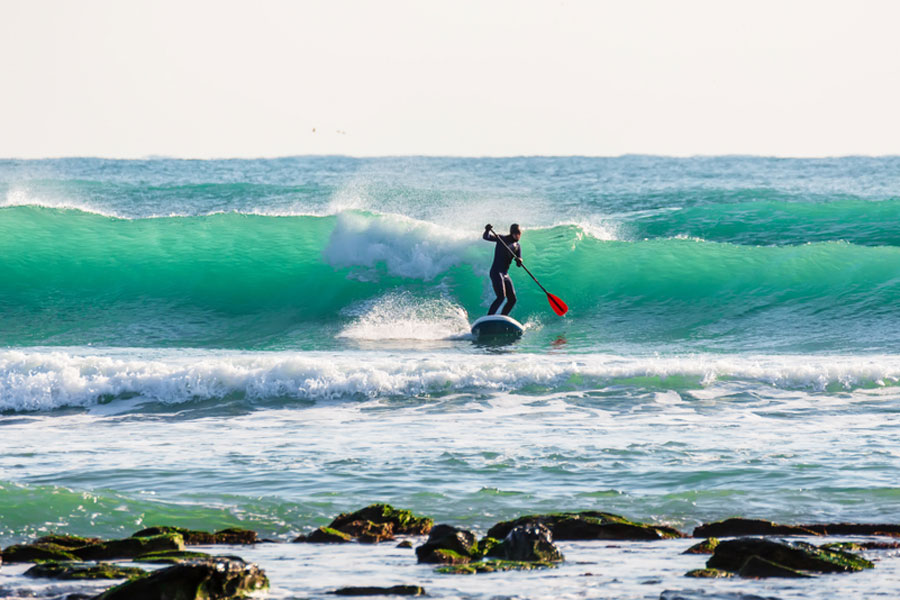
Only Ride Waves You Can Handle
Whether you’re bodyboarding, surfing, sailing, or stand up paddle boarding, you’re likely going to be facing some challenging waves. And when you’re just starting out, it’s definitely a bad idea to take on big waves. Save it for later. Meanwhile, start with smooth, smaller waves until you garner more experience and gain a better understanding of the flow and power of the water.
We hope these paddle boarding tips will help you become a better paddler and allow you to have a wonderful and safe time in the water. For a more comprehensive tutorial on stand up paddle boarding, check out this instructional video:

